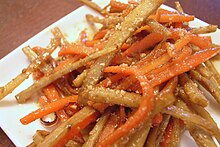
Kinpira (金平) is a Japanese cooking style that can be summarized as a technique of sauté and simmer.[1] The most common dish made with this technique is Kinpira Gobo, braised burdock root.[2] Kinpira is commonly used to cook root vegetables such as carrots, burdock root, and lotus root;[1][2] skins of squash such as Kabocha; vegetables such as mushrooms or broccoli;[3][4] seaweeds such as arame and hijiki;[4] other foods including tofu, capsicums, and wheat gluten (namafu); and meat such as chicken thigh, pork, and beef.[5][6] The base sauce is made up of soy sauce, mirin, sugar, and chili peppers.[2][7]
Kinpira is named after the son of Kintarō, a Japanese folk hero.[8][3]
References
[edit]- ^ a b Yoshizuka, Setsuko (2021-08-01). "Make Kinpira Gobo". The Spruce Eats. Retrieved 2022-04-17.
- ^ a b c Shihoko (2019-12-20). "Kinpira Gobo braised burdock root". Chopstick Chronicles. Retrieved 2022-04-17.
- ^ a b "Ginger Kinpira with Mushrooms". Tasty Tokyo Times. 2020-07-14. Retrieved 2022-04-17.
- ^ a b "VEGAN KINPIRA ONIGIRAZU". Miwa's Japanese Cooking. 2022-02-05. Retrieved 2022-04-17.
- ^ "KINPIRA GOBO WITH CHICKEN". No Recipes. n.d. Retrieved 2022-04-17.
- ^ Chen, Namiko (2022-01-20). "Kinpira Gobo (Braised Burdock Root) (Video) きんぴらごぼう". Just One Cookbook. Retrieved 2022-04-17.
- ^ "Technique: Kinpira". Taste Atlas. n.d. Retrieved 2022-04-17.
- ^ "Kinpira Gobo (Japanese style stir-fried burdock root with carrot, きんぴらごぼう)". Tabemono Madness. 2021-04-10. Retrieved 2022-04-17.
Well, that’s interesting to know that Psilotum nudum are known as whisk ferns. Psilotum nudum is the commoner species of the two. While the P. flaccidum is a rare species and is found in the tropical islands. Both the species are usually epiphytic in habit and grow upon tree ferns. These species may also be terrestrial and grow in humus or in the crevices of the rocks.
View the detailed Guide of Psilotum nudum: Detailed Study Of Psilotum Nudum (Whisk Fern), Classification, Anatomy, Reproduction